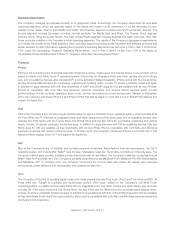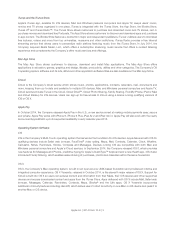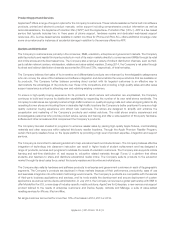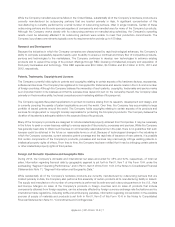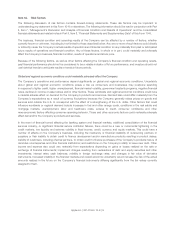Apple 2014 Annual Report Download - page 13
Download and view the complete annual report
Please find page 13 of the 2014 Apple annual report below. You can navigate through the pages in the report by either clicking on the pages listed below, or by using the keyword search tool below to find specific information within the annual report.To remain competitive and stimulate customer demand, the Company must successfully manage frequent product
introductions and transitions.
Due to the highly volatile and competitive nature of the industries in which the Company competes, the Company must
continually introduce new products, services and technologies, enhance existing products and services, and effectively
stimulate customer demand for new and upgraded products. The success of new product introductions depends on a number
of factors including, but not limited to, timely and successful product development, market acceptance, the Company’s ability
to manage the risks associated with new product production ramp-up issues, the availability of application software for new
products, the effective management of purchase commitments and inventory levels in line with anticipated product demand,
the availability of products in appropriate quantities and at expected costs to meet anticipated demand, and the risk that new
products may have quality or other defects or deficiencies in the early stages of introduction. Accordingly, the Company cannot
determine in advance the ultimate effect of new product introductions and transitions.
The Company depends on the performance of distributors, carriers and other resellers.
The Company distributes its products through cellular network carriers, wholesalers, national and regional retailers, and value-
added resellers, many of whom distribute products from competing manufacturers. The Company also sells its products and
third-party products in most of its major markets directly to education, enterprise and government customers, and consumers
and small and mid-sized businesses through its online and retail stores.
Carriers providing cellular network service for iPhone typically subsidize users’ purchases of the device. There is no assurance
that such subsidies will be continued at all or in the same amounts upon renewal of the Company’s agreements with these
carriers or in agreements the Company enters into with new carriers.
Many resellers have narrow operating margins and have been adversely affected in the past by weak economic conditions.
Some resellers have perceived the expansion of the Company’s direct sales as conflicting with their business interests as
distributors and resellers of the Company’s products. Such a perception could discourage resellers from investing resources in
the distribution and sale of the Company’s products or lead them to limit or cease distribution of those products. The Company
has invested and will continue to invest in programs to enhance reseller sales, including staffing selected resellers’ stores with
Company employees and contractors, and improving product placement displays. These programs could require a substantial
investment while providing no assurance of return or incremental revenue. The financial condition of these resellers could
weaken, these resellers could stop distributing the Company’s products, or uncertainty regarding demand for the Company’s
products could cause resellers to reduce their ordering and marketing of the Company’s products.
The Company faces substantial inventory and other asset risk in addition to purchase commitment cancellation risk.
The Company records a write-down for product and component inventories that have become obsolete or exceed anticipated
demand or net realizable value and accrues necessary cancellation fee reserves for orders of excess products and
components. The Company also reviews its long-lived assets, including capital assets held at its suppliers’ facilities and
inventory prepayments, for impairment whenever events or circumstances indicate the carrying amount of an asset may not be
recoverable. If the Company determines that impairment has occurred, it records a write-down equal to the amount by which
the carrying value of the assets exceeds its fair value. Although the Company believes its provisions related to inventory, capital
assets, inventory prepayments and other assets and purchase commitments are currently adequate, no assurance can be
given that the Company will not incur additional related charges given the rapid and unpredictable pace of product
obsolescence in the industries in which the Company competes.
The Company must order components for its products and build inventory in advance of product announcements and
shipments. Consistent with industry practice, components are normally acquired through a combination of purchase orders,
supplier contracts and open orders, in each case based on projected demand. Where appropriate, the purchases are applied
to inventory component prepayments that are outstanding with the respective supplier. Purchase commitments typically cover
forecasted component and manufacturing requirements for periods up to 150 days. Because the Company’s markets are
volatile, competitive and subject to rapid technology and price changes, there is a risk the Company will forecast incorrectly
and order or produce excess or insufficient amounts of components or products, or not fully utilize firm purchase
commitments.
Apple Inc. | 2014 Form 10-K | 11



